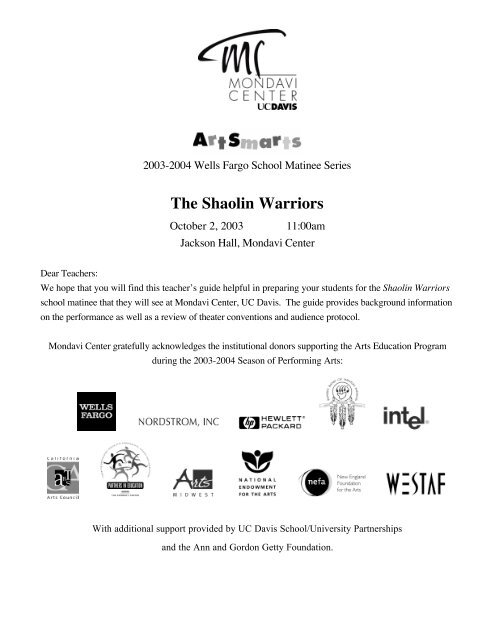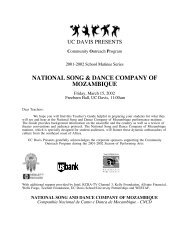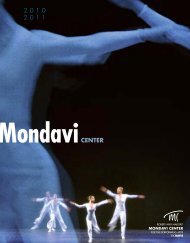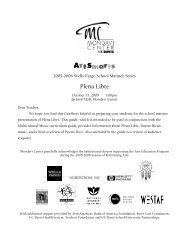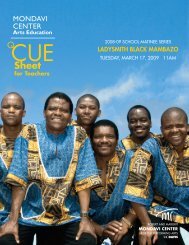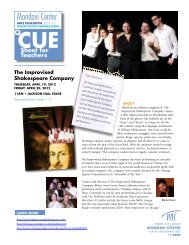The Shaolin Warriors - Mondavi Center - UC Davis
The Shaolin Warriors - Mondavi Center - UC Davis
The Shaolin Warriors - Mondavi Center - UC Davis
You also want an ePaper? Increase the reach of your titles
YUMPU automatically turns print PDFs into web optimized ePapers that Google loves.
2003-2004 Wells Fargo School Matinee Series<br />
<strong>The</strong> <strong>Shaolin</strong> <strong>Warriors</strong><br />
October 2, 2003 11:00am<br />
Jackson Hall, <strong>Mondavi</strong> <strong>Center</strong><br />
Dear Teachers:<br />
We hope that you will find this teacher’s guide helpful in preparing your students for the <strong>Shaolin</strong> <strong>Warriors</strong><br />
school matinee that they will see at <strong>Mondavi</strong> <strong>Center</strong>, <strong>UC</strong> <strong>Davis</strong>. <strong>The</strong> guide provides background information<br />
on the performance as well as a review of theater conventions and audience protocol.<br />
<strong>Mondavi</strong> <strong>Center</strong> gratefully acknowledges the institutional donors supporting the Arts Education Program<br />
during the 2003-2004 Season of Performing Arts:<br />
With additional support provided by <strong>UC</strong> <strong>Davis</strong> School/University Partnerships<br />
and the Ann and Gordon Getty Foundation.
THE SHAOLIN WARRIORS<br />
Nearly fifteen hundred years ago, in their original <strong>Shaolin</strong> Temple in the Henan<br />
province of mainland China (southwest of Beijing), the <strong>Shaolin</strong> monks originated the art of<br />
Kung fu. Training daily for many hours in a practice of Buddhist meditation known as<br />
Ch’an or Zen, the monks have cultivated remarkable skill in focusing and directing the life<br />
force, or energy, which they refer to as “ch’i.” <strong>The</strong> <strong>Shaolin</strong> <strong>Warriors</strong> will feature 23<br />
monks in a choreographed theatrical performance portraying a typical day at the temple,<br />
from dawn to dusk. <strong>The</strong> audience will experience the serenity of morning meditation,<br />
chanting, exercises, and amazingly synchronized fighting rituals often employing an array<br />
of traditional <strong>Shaolin</strong> weaponry.<br />
<strong>Mondavi</strong> <strong>Center</strong> ArtSmarts pg. 2<br />
TEMPLE LIFE<br />
A <strong>Shaolin</strong> temple housed an active and highly organized community of students and<br />
teachers. <strong>The</strong>re were three basic classes of participant: students, disciples, and masters. <strong>The</strong><br />
monastery also attracted scholars and artists who found a conducive solitude in which to do
their work. Larger monasteries became important learning and culture centers as well as<br />
strong economic powerbases. When a child (more typically a boy, but girls also were<br />
trained) was admitted to the temple to study for the priesthood, he or she would be assigned<br />
the most menial tasks: cooking meals, washing clothes, cleaning and grounds upkeep. <strong>The</strong><br />
discipline of the work and submission to the authority of the teachers would prepare the<br />
student for the years ahead spent coordinating body and mind. Days were also spent<br />
learning to read and write, studying math, history, philosophy, art, agriculture, and cooking.<br />
<strong>The</strong> apprentice was expected to become both culturally literate and self-sufficient.<br />
When the student entered the level of disciple, she or he would spend from two to<br />
four years in the study of the <strong>Shaolin</strong> arts of combat (Kung Fu) as well as continue<br />
schooling in Buddhist ethics. <strong>The</strong> disciple would master more advanced combat techniques:<br />
weapons use, coordinating breath, mediation, and controlling the “ch’i” (life force). <strong>The</strong><br />
monks believe that the ability to harness “ch’i” would allow a person of average build and<br />
strength to crack bricks with the bare hand and to sense the position and movements of an<br />
opponent in the dark. <strong>The</strong> advanced disciples might also write books of poetry or natural<br />
history, paint or learn medicine.<br />
If and when the disciple mastered and perfected the techniques of Kung Fu, he or<br />
she would be awarded the full status of <strong>Shaolin</strong> monk. Now, it would be his/her role to<br />
teach what had been learned to new students.<br />
KUNG FU<br />
Kung Fu, Gong Fu in Chinese, means “skill.” It is an ancient combat art as well as<br />
a form of disciplined exercise. <strong>The</strong> basic moves include stances, punches, and kicks. When<br />
used as a form of meditation, movements would coordinate with breathing and the student<br />
would learn to identify and work with “ch’i” (life force). Kung Fu develops self-control,<br />
muscular coordination, and preparedness. <strong>The</strong> power of the practitioner exists in his or her<br />
ability to defend against near impossible odds and situations. <strong>The</strong> various movements were<br />
based on the fighting tactics of animals: examples include the Tiger, Crane, Dragon,<br />
Leopard, Monkey, and Cobra.<br />
It is sometimes confusing for Western audiences to connect the Buddhist teachings<br />
of non-violence and the discipline of Kung Fu practiced in the monasteries. <strong>The</strong> martial arts<br />
master will make an important distinction: the <strong>Shaolin</strong> practitioner is never an attacker, and<br />
she or he will use skill to avoid conflict. <strong>The</strong> Kung Fu expert may parry an attack, however,<br />
if the assailant is intent upon violence, the monk will end the assault with a decisive lock-<br />
<strong>Mondavi</strong> <strong>Center</strong> ArtSmarts pg 3
hold or knock out. <strong>The</strong> art may also be understood symbolically, as a means to combat the<br />
wayward self, to restrain ego and develop psychological control.<br />
<strong>The</strong> <strong>Shaolin</strong> Temple Kung Fu style has two divisions: southern temples prefer hand<br />
techniques while northern temples emphasize kicks and footwork.<br />
BUDDHISM<br />
<strong>The</strong> <strong>Shaolin</strong> philosophy was founded in Buddhism and later adopted Taoist<br />
principles. Before the introduction of Buddhism into China from India, the two main<br />
religions were Confucianism and Taoism. Confucianism entailed the observation of<br />
propriety and proper social relationships. Taoism, in turn, declined the outer world in order<br />
to seek wisdom in the pursuit of harmony with the Tao (Way). <strong>The</strong> <strong>Shaolin</strong> spiritual<br />
practice united both native currents (community and interiority) within the metaphysics of<br />
Buddhism.<br />
Buddhism’s principle tenet is the quest for release from the changes and chances of the<br />
world, and the search for serenity in the enlightened state called Nirvana. <strong>The</strong> Chinese<br />
development of Ch’an Buddhism emphasized meditation as a discipline of the mind<br />
leading to the final goal of spiritual freedom.<br />
Buddhism began in India between the 6 th –5 th century BC with the historical figure<br />
of GAUTAMA, sometimes called SIDDHARTHA. <strong>The</strong> term BUDDHA, literally “the<br />
awakened one” or “enlightened one,” is a title and not a proper name. Gautama was the<br />
son of a king and queen, descendants of the Khattiya or ruling, warrior caste. Many legends<br />
surround the Buddha’s life. He was brought up in royal luxury then rejected comfort and<br />
privilege for the life of a wandering ascetic. Gautama’s enlightenment came while he sat in<br />
meditation under a bodhi tree. <strong>The</strong> following words are attributed to him: “My mind was<br />
emancipated, . . .Ignorance was dispelled, science (knowledge) arose; darkness was<br />
dispelled, light arose.” He continued his life wandering, teaching, and gathering disciples to<br />
him, well into his 80 th year.<br />
<strong>Mondavi</strong> <strong>Center</strong> ArtSmarts pg 4
CHINA<br />
CHINA, officially the Peoples Republic of China, is a nation of enormous physical<br />
dimensions, rich and ancient cultural history, and powerful influence in the world today. It is<br />
the largest of all of the Asian nations, as large as Europe, and has the largest population of<br />
any country in the world (one-fifth the world population). Occupying approximately onefourteenth<br />
of the land area of the Earth, China stretches for 3100 miles from east to west<br />
and 3400 miles from north to south. Beijing is the capital as well as the cultural, economic,<br />
and communications center. Shanghai is the major industrial city, and Hong Kong is the<br />
leading commercial center and port city. Chinese geography is as diverse as its other<br />
features--including the highest point (Mt. Everest, 29,035 feet) and one of the lowest places<br />
(Turfan Depression in the Sinkiang region, 505 feet below sea-level) on the planet. <strong>The</strong><br />
climate can be arid and desert-like in the northwest and tropical in the southeast.<br />
Chinese history can be back-dated in the historical records for 4000 years. Much of<br />
China’s development occurred in isolation, with the notable exception of the introduction of<br />
Buddhism from India. And, even when invading groups, like the Manchus, conquered<br />
territory, they were summarily absorbed into the Chinese culture. <strong>The</strong> isolation allowed for<br />
the development and maturation of a distinctly Chinese civilization but also resulted in<br />
China’s unpreparedness to cope with the technological and military advances of the rest of<br />
the world, particularly after the mid-19th century. <strong>The</strong> challenge to change resulted in the<br />
revolution at the beginning of the Twentieth century and culminated in the establishment of<br />
the Communist government in 1949. <strong>The</strong> unification and consolidation of forces has<br />
brought China to a competitive status on the world stage.<br />
MAP OF CHINA<br />
<strong>Mondavi</strong> <strong>Center</strong> ArtSmarts pg 5
-map taken from http://www.lonelyplanet.com<br />
THINK ABOUT IT!<br />
Talking with your teacher, friends and family about a performance after attending<br />
the theater is part of the experience. When you share what you saw and felt you learn more<br />
about the performance. You can now compare ideas and ask questions and find out how to<br />
learn even more. Here are some questions to think about:<br />
<strong>Mondavi</strong> <strong>Center</strong> ArtSmarts pg 6
1) Many of the Kung Fu combat tactics are modeled on the stances and behaviors of<br />
animals. What animals or insects did you recognize during the performance? Can you<br />
describe the specific qualities of the movements that helped you identify the animal?<br />
2) Do you study an instrument or practice a sport? How does the discipline of your<br />
practice help you grow as a person?<br />
3) What did you like best about the performance and why? Was the program different<br />
from what you expected? How?<br />
4) How would you describe the <strong>Shaolin</strong> <strong>Warriors</strong> performance to a friend?<br />
<strong>Mondavi</strong> <strong>Center</strong> ArtSmarts pg 7
ATTENDING THE THEATER<br />
What is expected of student audiences at the matinee:<br />
· Enter the auditorium quietly and take seats immediately (note that all matinees now have<br />
reserved seating);<br />
· Show courtesy to the artist and other guests at all times;<br />
· Demonstrate appreciation for the artist’s work by applauding at the appropriate times;<br />
· Refrain from making unnecessary noise or movements;<br />
· Please eat lunch before or after the performance to avoid disruption;<br />
· Relate any information acquired from the pre-matinee discussion to the new information<br />
gained from the matinee;<br />
· Please do not use flash photography.<br />
What you can expect of your experience in a performing arts theater:<br />
A theater is a charged space, full of energy and anticipation. When the house lights (the<br />
lights that illuminate the audience seating) go down, the excitement level goes up! <strong>The</strong>aters<br />
are designed so that the voices of the singers and actors and the music of the musicians can be<br />
heard. But this also means that any sound in the audience: whispering, rustling of papers,<br />
speaking and moving about, can be heard by other audience members and by the performers.<br />
Distractions like these upset everyone’s concentration and can spoil a performance.<br />
<strong>The</strong> performers on stage show respect for their art form and for the audience by doing<br />
their very best work. <strong>The</strong> audience shows respect for the performers by watching attentively.<br />
Applause is the best way for audience members to share their enthusiasm and to show their<br />
appreciation for the performers. Applaud at the end of a performance! Sometimes the<br />
audience will clap during a performance, as after a featured solo. Audience members may<br />
feel like laughing if the action on stage is funny, crying if the action is sad, or sighing if<br />
something is seen or heard that is beautiful. Appreciation can be shown in many different<br />
ways, depending upon the art form and the culture(s) of the people in the audience. While the<br />
audience at a dance performance will sit quietly, other types of performance invite audience<br />
participation.<br />
This Teacher’s Guide was written by ANETT JESSOP, Graduate Program Coordinator,<br />
Department of English, <strong>UC</strong> <strong>Davis</strong><br />
<strong>Mondavi</strong> <strong>Center</strong> ArtSmarts pg 8


